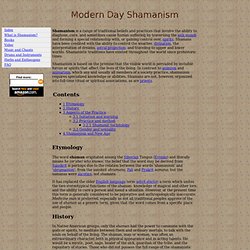

Giving up the Green Bitch: Reflections on Cannabis, Ayahuasca and the mystery of plant teachers by Graham Hancock. I have some personal stuff to share here and I intend to do so with complete openness in the hope that my experiences will prove helpful to some, thought-provoking to others, and might stir up discussion around issues of consciousness and cognitive liberty that are often neglected in our society.

I'll soon be on on my way to Brazil for what has become pretty much an annual pilgrimage to drink the visionary brew known as Ayahuasca, the "Vine of Souls", sacred amongst shamanistic cultures of the Amazon for thousands of years. I’m not doing this for fun, or for recreation. Drinking Ayahuasca is an ordeal. Richard Evans Schultes and Siri Von Reis - Book Review: Ethnobotany: Evolution of a Discipline - Bulletin of the History of Medicine 72:3. In lieu of an abstract, here is a brief excerpt of the content: Bulletin of the History of Medicine 72.3 (1998) 595-596 Book Review Richard Evans Schultes and Siri von Reis, eds.

Ethnobotany: Evolution of a Discipline. Portland, Ore.: Timber Press, 1995. 414 pp. As a word, ethnobotany is just a century old: it was coined by the American taxonomic botanist John W. Samui1. Peyote Vault : Timeline. "Comanche Jack was also said to have tended fire for Charcoal, to have been a subchief to Quanah Parker, and to have been the first to use the name of Jesus in peyote meetings.

" Stewart OC. Peyote Religion, page 70. "In 1880, with the availability of peyote and the new stability of life on the reservation, peyotism spread rapidly. [...] Gnerally, the person who wished to become a roadman was already distinguished as a medicine man. Often he was a tribal leader or chief who had attended one of the schools or the prisomer-of-war camp, who understood English and something about white culture and religion, or who was otherwise outstanding. A Brief History of Peyote. Terence McKenna Vault : The High Times Interview.
Did hallucinogens play a crucial role in human evolution?

Terence McKenna has devoted most of his life to exploring this question. A specialist in the ethnomedicine of the Amazon Basin, McKenna along with his partner Kat Harrison McKenna founded Botanical Dimensions, a nonprofit foundation devoted to rescuing Amazonian plants that have a history of shamanic uses. They move the plants to a 19-acre site in Hawaii and preserve the details of the plant's uses by storing the information in a computer database. In addition to preserving these important plants, as a nonprofit organization, Botanical Dimensions solicits donations to publish a newsletter and to aid in carrying out the preservation of the folk knowledge of the peoples native to the Amazon area. HIGH TIMES: Tell us how you became interested in shamanism and the exploration of consciousness. Terence McKenna: I discovered shamanism through an interest in Tibetan folk religion. Whonamedit - Silas Weir Mitchell. American physician and author, born February 15, 1829, Philadelphia, Pennsylvania; died January 4, 1914, Philadelphia.

Silas Weir Mitchell was born in Philadelphia to a family of Scottish origin, the seventh physician in three generations. His father was John Kearsley Mitchell (1798-1858), a physician and lecturer at Jefferson Medical College in Philadelphia; his mother was Matilda Henry Mitchell (1800-1872). James Mooney. James Mooney, Smithsonian Institute Ethnologist (1861-1921) had an unassailable desire to understand and record the American Native Culture that started in his very early youth.

He came to know the decedents of Osceola’s daughters. He subsequently became acquainted with many of Osceola’s descendants. PhosphorescentDesertButtons. Peyote (also Lophophora williamsii) Main Index. What is Shamanism? - Modern Day Shamanism. Shamanism is a range of traditional beliefs and practices that involve the ability to diagnose, cure, and sometimes cause human suffering by traversing the axis mundi and forming a special relationship with, or gaining control over, spirits.

Shamans have been credited with the ability to control the weather, divination, the interpretation of dreams, astral projection, and traveling to upper and lower worlds. Shamanistic traditions have existed throughout the world since prehistoric times. Shamanism is based on the premise that the visible world is pervaded by invisible forces or spirits that affect the lives of the living. In contrast to animism and animatism, which any and usually all members of a society practice, shamanism requires specialized knowledge or abilities. Shamans are not, however, organized into full-time ritual or spiritual associations, as are priests. Etymology History There is a strong shamanistic influence in the Bön religion of central Asia, and in Tibetan Buddhism. Www.transpersonalstudies.org/ImagesRepository/ijts/Downloads/Winkelman Cosmology Article.pdf. Betel nut beauties told to cover up. TAIPEI, Taiwan (CNN) -- Selling betel nuts is a cut-throat business in Taiwan.
This mild stimulant is chewed by millions of Taiwanese -- the vast majority male. Which is why many female roadside vendors have found that skimpier outfits equals higher sales. But showing flesh to peddle nuts has riled many people in Taiwan.